
Raymond "Ossie" Clark was a British fashion designer who was a major figure in the Swinging Sixties scene in London and the fashion industry in that era. Clark is now renowned for his vintage designs by present-day designers.
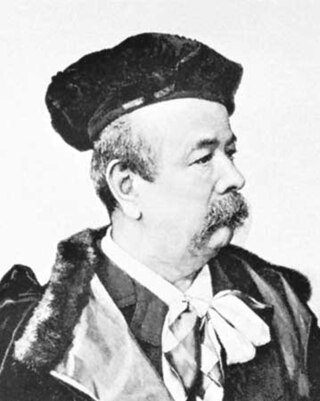
Charles Frederick Worth was an English fashion designer who founded the House of Worth, one of the foremost fashion houses of the 19th and early 20th centuries. He is considered by many fashion historians to be the father of haute couture. Worth is also credited with revolutionising the business of fashion.

Nicole Miller is an American fashion designer and businesswoman.

Children's clothing or kids' clothing is clothing for children who have not yet grown to full height. Children's clothing is often more casual than adult clothing, fit for play and rest.
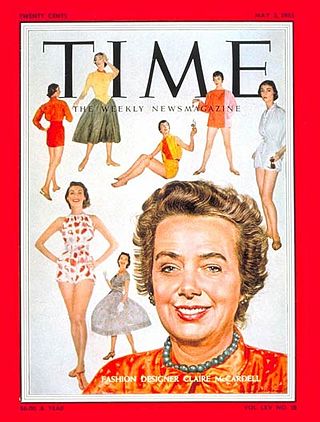
Claire McCardell was an American fashion designer of ready-to-wear clothing in the twentieth century. She is credited with the creation of American sportswear.

A wrap dress is generic term for a dress with a front closure formed by wrapping one side across the other, and is fastened at the side or tied at the back. This forms a V-shaped neckline. A faux wrap dress resembles this design, except that it comes already fastened together with no opening in front, but instead is slipped on over the head. A wrap top is a top cut and constructed in the same way as a wrap dress, but without a skirt. The design of wrap-style closure in European garments was the results of the heavy influences of Orientalism which was popular in the 19th century.

Mila Schön was an Italian fashion designer. Her surname was also spelled as Schoen.
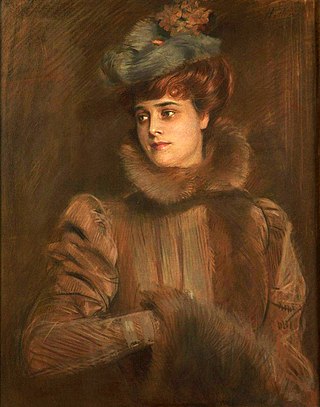
Madame Louise Chéruit (1866-1955), born Louise Lemaire, often erroneously called Mme Madeleine Chéruit, was among the foremost couturiers of her generation, and one of the first women to control a major French fashion house. Her salon operated in the Place Vendôme in Paris under the name Chéruit from 1906 to 1935. Chéruit is best remembered today as the subject of a number of portraits by Paul César Helleu, with whom she conducted an affair before opening her couture house and for the appearance of her name in two celebrated works of literature, Marcel Proust's Remembrance of Things Past (1910) and Evelyn Waugh's Vile Bodies (1930). Her name is also frequently associated with the fashion photography of Edward Steichen whose favorite model, Marion Morehouse, often wore gowns from the house of Chéruit for Vogue magazine in the 1920s. One particular Steichen image has become iconic: Morehouse in a jet-beaded black net Chéruit dress, first published in 1927.
Bonnie Cashin was an American fashion designer. Considered a pioneer in the design of American sportswear, she created innovative, uncomplicated clothing that catered to the modern, independent woman beginning in the post-war era through to her retirement from the fashion world in 1985.

Vera Huppe Maxwell was an American pioneering sportswear and fashion designer.
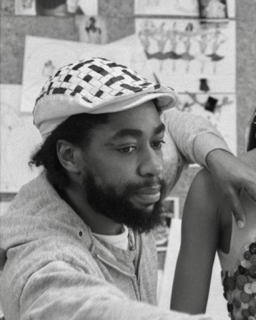
Patrick Kelly was an American fashion designer who came to fame in France. Among his accomplishments, he was the first American to be admitted to the Chambre syndicale du prêt-à-porter des couturiers et des créateurs de mode, the prestigious governing body of the French ready-to-wear industry. Kelly's designs were noted for their exuberance, humor and references to pop culture and Black folklore.
Mary Ping is an American fashion designer based in New York City. She is best known for her conceptual label "Slow and Steady Wins the Race", although she has also designed under her own label.
Mollie Parnis, later Livingston, was an American fashion designer. She belongs to the first generation of American designers to be known to the public by name rather than by affiliation to a department store and is best known for designing clothing worn by many First Ladies, as well as the uniform of the Cadet Nurse Corps in World War II.

Milly is an American fashion company. Specializing in women’s clothing, it was founded in 2000 by fashion designer Michelle Smith and Andrew Oshrin. The company is based in New York City and retails worldwide in department stores, via its own boutiques, its website and wholesales primarily to department stores. Smith and Oshrin ran the company until 2019 when it sold to S. Rothschild.
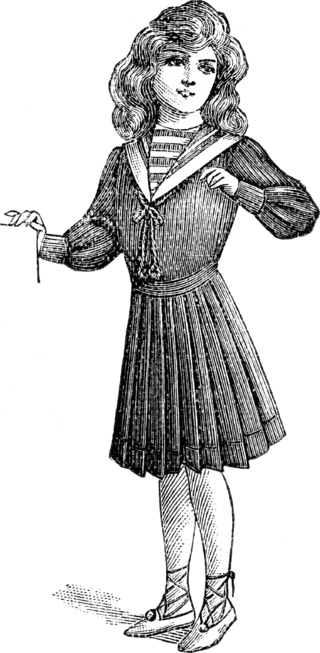
A sailor dress is a child's or woman's dress that follows the styling of the sailor suit, particularly the bodice and collar treatment. A sailor-collared blouse is called a middy blouse. In early 20th-century America, sailor dresses were very popularly known as Peter Thomson dresses after the former naval tailor credited with creating the style.
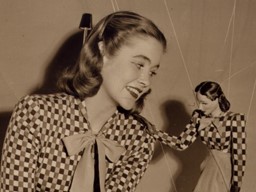
Emily Wilkens was an American fashion designer specializing in children's wear. She won both the Neiman Marcus Fashion Award and the Coty Award for her work, which was considered groundbreaking for properly taking note of the requirements of teenage dressing, and not simply offering miniature grown-up garments. She was also an author, writing a number of books on self care and style, and during the late 1960s and early 1970s, became a beauty journalist, writing an advice column.
Carolyn Schnurer was a fashion designer and a pioneer in American sportswear. Schnurer's designs have been featured in the magazines Vogue, Harper's Bazaar, and Life as well as in the Metropolitan Museum of Art. She has also received awards for her designs from Coty, The Cotton Council, International Sportswear, Miami Sportswear, and Boston Sportswear.
Diana Dew was an American fashion designer recognized in the 1960s for pioneering electronic clothes. She created clothing that was able to light up, was battery-powered, and was controlled via a switch.
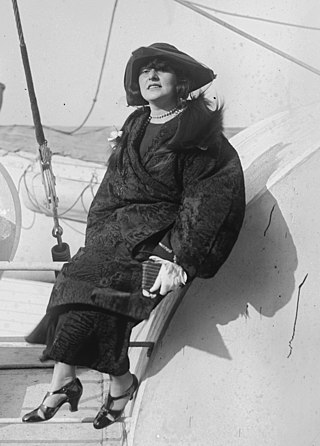
Sally Milgrim was an American businesswoman and fashion designer. She notably designed the dress Eleanor Roosevelt wore to her husband's first inaugural ball.
Carol Spencer is an American fashion designer. Most of her career from the early 1960s until 1999 was devoted to creating fashion for Barbie.














